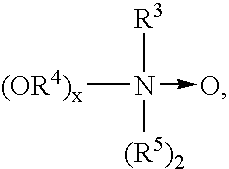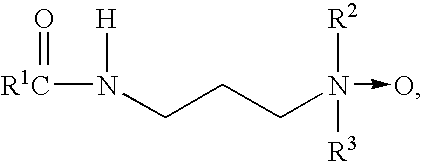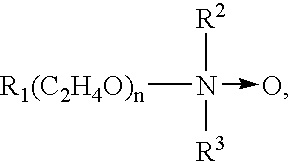Process for forming a low density detergent granule
a detergent granule, low-density technology, applied in detergent compounding agents, chemical instruments and processes, detergent compositions, etc., can solve the problems of limiting the feasibility of additional processing, lumps and/or other undesirable physical characteristics, affecting the granule flow, etc., to achieve low organic level, high granule strength, and low cake strength
- Summary
- Abstract
- Description
- Claims
- Application Information
AI Technical Summary
Benefits of technology
Problems solved by technology
Method used
Image
Examples
example 1
[0055] Anionic surfactant, sodium sulfate, 13% sodium silicate 2.4r, 4% sodium salt copolymer of acrylate and maleate (MW about 10,000), 3% sodium toluene sulphonate, other polymeric material, and optical brightener are mixed in a crutcher at about 60˜70° C. until evenly blended to form a homogeneous slurry. The crutcher mix moisture is 40%. This is passed to a drop tank, passed through a grinder, injected with air at a rate of 0.08% and pumped to a spray drying tower having 1 dual fluid nozzle arranged in a concurrent, straight air-flow configuration. The slurry is atomized by the compress air. The air inlet temperature is from 150-240° C., and the spraying pressure is about 200 kPa. The tower outlet temperature is about 70-90° C. The granules fall into a fluid bed dryer and get further dried. The final product has an average bulk density of about 450-500 g / L, and a low cake strength ˜0.3 kg, good solubility and excellent flowability.
example 2
[0056] A slurry is made same as above Example 1 except that 15% sodium silicate 1.6r is used balanced by sodium sulfate. The product produced under same spray drying condition has a higher bulk density of about 500˜600 g / L.
example 3
[0057] A slurry is made according to Example 1 except that 24% sodium silicate 1.6r is used balanced by sodium sulfate. The slurry is very difficult to dry in the spray drying tower. It tends to stick on the tower walls and the amount of granule generated is much less (only about 60%) than previous Examples 1-2 even the same amount of slurry goes through the tower. Very big lumps are also found at the bottom of tower.
PUM
| Property | Measurement | Unit |
|---|---|---|
| pressure | aaaaa | aaaaa |
| temperature | aaaaa | aaaaa |
| density | aaaaa | aaaaa |
Abstract
Description
Claims
Application Information
 Login to View More
Login to View More - R&D
- Intellectual Property
- Life Sciences
- Materials
- Tech Scout
- Unparalleled Data Quality
- Higher Quality Content
- 60% Fewer Hallucinations
Browse by: Latest US Patents, China's latest patents, Technical Efficacy Thesaurus, Application Domain, Technology Topic, Popular Technical Reports.
© 2025 PatSnap. All rights reserved.Legal|Privacy policy|Modern Slavery Act Transparency Statement|Sitemap|About US| Contact US: help@patsnap.com



